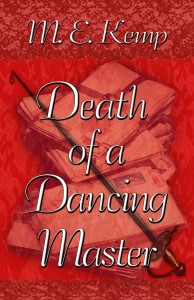 Relevant History welcomes author Laura Vosika. Vosika grew up in the military, experiencing European castles and the history of America's east coast. She earned degrees in music and education, and worked for years as both a freelance musician and music educator. In addition to finishing the Blue Bells Trilogy (historical/paranormal fiction and adventure), she has several other novels and two non-fictions in progress. She is the mother of nine, currently living in Minnesota. For more information, check her web site and blog.
Relevant History welcomes author Laura Vosika. Vosika grew up in the military, experiencing European castles and the history of America's east coast. She earned degrees in music and education, and worked for years as both a freelance musician and music educator. In addition to finishing the Blue Bells Trilogy (historical/paranormal fiction and adventure), she has several other novels and two non-fictions in progress. She is the mother of nine, currently living in Minnesota. For more information, check her web site and blog.
***
Do circumstances make men, or do men make circumstances? I believe sometimes one and sometimes another.
Robert Bruce, Earl of Carrick, was born in 1274 into one of Scotland’s foremost noble families, in the last days of Alexander III’s golden reign of peace over Scotland. Bruce was the oldest of five sons and third of ten children. He is said to have been a bit headstrong, hot-tempered, and willful in his younger days. What would he have been, had Alexander had sons of his own? It’s very possible history would barely remember him.
As it was, Alexander, in a particularly tragic twist of fate, died of a broken neck exactly because of his haste to get home to his bride on a dark and stormy night. He didn’t reach her, and there was no heir.
Edward I of England had long had his eye on Scotland’s throne. Dispute broke out among thirteen competitors for the crown, including Robert Bruce’s grandfather. When Scotland’s nobles, fearing civil war, asked Edward to choose among the claimants, they unwittingly opened the door. Edward chose John Baliol, believing he’d chosen the one he’d best be able to control as a puppet king. Baliol, however, soon enough defied Edward, refusing to send troops for his war in France. This led to the events most Americans know through the movie Braveheart.
Like the American Revolution, the struggle of Robert the Bruce, William Wallace, and the Scottish people was that of a smaller, weaker country, poorer and more poorly-equipped, against what must have seemed a military giant in comparison. There must have been those who believed Scotland could never win. Perhaps the complete futility of the struggle is best seen in the words of Elizabeth de Burgh, Robert the Bruce’s queen, at their coronation in March of 1306: We are but king and queen of the May.
They were crowned in a rush, attended by only a few clerics and close friends. Bruce effectively had no country, no home, no castle of his own, and very little of an army to fight England. Scotland itself was in turmoil, with its nobles taking sides against one another.
If the situation looked bleak at the time of Robert and Elizabeth’s crowning, it soon grew worse. Bruce, with his few followers, his wife, daughter, sisters, four brothers, and the valiant Isabel MacDuff, took to the hills. He suffered military defeats at Methven and Dalry in the summer of 1306. When he sent the women to safety under the protection of his brother Nigel and his close friend Christopher Seton, they were betrayed: his wife, daughter, sisters, and Isabel captured and imprisoned, and Nigel and Christopher brutally executed. Bruce himself was largely a fugitive either living in the wilderness or relying on the hospitality of his subjects to house himself and his remaining followers.
After a brief disappearance from the pages of history — with several guesses as to where he spent that winter — he returned to attack the English in the southwest of Scotland. Of his three surviving brothers, two more, Thomas and Alexander, were captured and executed. His attempts to take Scotland back from the English had now resulted in the captivity of his wife, only daughter, and two sisters, and the gruesome deaths of three of his four brothers. He pressed onward, seeing that Scotland needed to be free of its oppressors, whatever the personal cost.
Edward Longshanks died in July 1307, and over the next seven years, between Edward II’s less than stellar leadership, and Bruce’s military genius, Bruce, a man born to castles and comfort, lived a life of hardship and warfare, steadily united his people, removed his internal enemies, and re-took his castles and country, until, in 1313, Stirling Castle was one of only a few remaining in English hands.
Here, Bruce’s remaining brother, Edward, steps into the picture. He was ordered to besiege Stirling. He did so, but being a man who preferred action to waiting games, he made a deal with the governor of Stirling. Philp de Mowbray, the governor, knew he couldn’t hold out forever. So he agreed that if Edward II did not send relief troops by the next midsummer’s day, he would hand the castle over to Edward Bruce.
Robert, in his fight against a larger and better-equipped country, had relied on guerrilla tactics. Edward’s agreement forced him into pitched battle, matching his small force head to head against England’s might. History argues over just how much larger England’s force was at Bannockburn, but Bruce knew it would be anywhere from three to five times the size of his own.
 It is into this world, in the days leading up to that battle, that Shawn Kleiner, modern-day musical phenomenon, wakes up, in my novel, Blue Bells of Scotland. Shawn is more brash and hotheaded even than Bruce in his younger days. He is a man who has created his own circumstances, tuned the world around him to his preferred pitch, and bulldozes through life heedless of anything but his own desires, demanding and getting what he wants. Suddenly, he finds himself in circumstances he can no longer control, in the midst of men with daggers and pitchforks who can’t be bullied into singing his tune. Will he rise to the occasion like Bruce?
It is into this world, in the days leading up to that battle, that Shawn Kleiner, modern-day musical phenomenon, wakes up, in my novel, Blue Bells of Scotland. Shawn is more brash and hotheaded even than Bruce in his younger days. He is a man who has created his own circumstances, tuned the world around him to his preferred pitch, and bulldozes through life heedless of anything but his own desires, demanding and getting what he wants. Suddenly, he finds himself in circumstances he can no longer control, in the midst of men with daggers and pitchforks who can’t be bullied into singing his tune. Will he rise to the occasion like Bruce?
History is full of people like Bruce, thrust into circumstances not of their own making, and in turn made into someone completely different by those circumstances. Bit by bit over the years, the hotheaded Bruce of youth become a man of careful thought, diplomacy, patience, and humility who would lead his people in one of Scotland’s greatest battles and against a great oppressor.
Some of us are good at making our own circumstances. And although we don’t expect hostile military takeovers in our country, such as Bruce faced, or to wake up in the wrong century like Shawn, all of us, invariably, will at some point be thrust into situations we can no longer control: a cheating spouse, a business partner who steals, divorce, layoffs, accidents, a sick child, and sometimes, wars, natural disasters and more. What happens then?
Do we mourn our loss of control? Or do we allow those circumstances to turn us into someone greater than we would otherwise have been?
***
A big thanks to Laura Vosika for contributing. She’ll give away Blue Bells of Scotland in ebook form to someone who contributes a comment on my blog this week. I'll choose the winner from among those who comment by Friday at 6 p.m. ET and post the winner on Saturday.
Here's the new cover for the electronic version of Paper Woman, created by a professional artist. If you've read the book, you'll recall the scene that inspired this image. I'm also having cover images for The Blacksmith's Daughter and Camp Follower redone.


